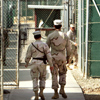Miami Herald reporter Carol Rosenberg has been covering the Guantanamo Bay detention center in Cuba for twelve years.
“The only people who have been at Gitmo longer than me are the prisoners,” she said in a recent phone interview.
As she packs her bags to return to Cuba in the coming weeks, she will arrive for the start of hurricane season. Her cellphone video of Hurricane Sandy shredding her tent at Gitmo last year is still fresh on her mind. She has no hopes of breaking a huge story or landing a newsmaking interview — at Gitmo, stories come in the form of tiny details.
It was her short video of a garbage can that helped prove the existence of a growing hunger strike at the detention camp. When that’s your beat, the little details are all you have to work with.
Covering a story with little to no access
Rosenberg cannot interview the prisoners. “The only prisoners I have ever spoken with are the ones who called me or emailed me after their release,” Rosenberg said. “They thanked me for writing about them.”
She is not allowed to take photos of the prisoners or get near them unless the Pentagon says she can. Yet by using everything from WikiLeaks to court records and other public records, she has managed to figure out the names of most of the Afghan, Saudi, Yemeni, Tunisian and other prisoners locked up at the camp.
“I organize the beat like a small town,” Rosenberg said. “It is a blend of being a small-town and a foreign correspondent. It involves court reporting and police reporting. I write about management changes; I follow the money, cover politics, weather and human-interest pieces.”
Every single picture and frame of video has to pass through government censors. Before even arriving on the island she — like the other journalists covering Guantanamo — must sign these ground rules that the government says “encourage open reporting and promote transparency, consistent with the Military Commissions Act.” The rules requires her to travel with government escorts.
The rules say “the Department of Defense is the sole release authority” for photos, videos and sketches gathered at Gitmo. Even if she hears something or sees something she is not supposed to, the guidelines forbid her from reporting it if the department believes the information could damage national security. It is no wonder that other journalists haven’t covered the story nearly as long as Rosenberg has.
As she wrote in a 2010 dispatch:
“Guantanamo’s Camp Justice is a place where you can sit at your laptop or by your phone only if there’s a member of the military within earshot.
It’s a place where you can go to court only in the custody of a military public affairs officer. Inside, if there’s only one escort — this happened recently — and somebody has to go to the bathroom, every reporter has to leave court, too.
It’s a place where a soldier stands over your shoulder, looks in your viewfinder and says ‘Don’t take that picture, I’ll delete it.’
Since 2002, 779 prisoners have been moved to Gitmo. 166 remain. Most are charged with no crime. As Rosenberg reported in 2011, the Obama administration “cleared 56 men for release without conditions, and identified 55 who should be repatriated to their homelands or transferred to other countries. Congressional restrictions prevent the vast majority of those transfers.” (In a recent speech, President Obama cited slightly different figures.) So the prisoners are stuck in Gitmo, with no end of their imprisonment in sight.
Reporting an ongoing story
Rosenberg and the Herald covered Guantanamo long before the first Afghanistan War prisoners arrived. In 1994 and 1995, the prison cells held thousands of Cuban and Haitians who were part of the balsero (“Cuban rafters”) crisis that washed up on Florida shores.
By 1999 the base — once featured in the movie “A Few Good Men” — was being downsized and headed for “caretaker status.”
“Gitmo was a gas station in the middle of the Caribbean for ships and airplanes,” Rosenberg said. “It has a church, a golf course, a school and a bowling alley. There is also one McDonald’s there.”
Three months after the 9/11 attacks, the U.S. military had collected so many prisoners in Afghanistan that the Pentagon had nowhere to put them. Some were suspected of being terrorists, enemy soldiers or knowing something about terrorist operations.
“The U.S. feared they wouldn’t control them,” Rosenberg recalled. “So the people who were considered truly valuable were put on ships. The government had a desire to gather intelligence. The thrust of their interest was ‘Where is bin Laden?’ and ‘When and where is the next attack coming?’ ”
Rosenberg said the government had to choose where to send the prisoners it wanted to question: “It was either going to be Guam or Cuba. December 27th, 2001, Defense Secretary Donald Rumsfeld said the ‘least worst place’ was Gitmo.”
In December 2001, Rosenberg’s editor at the time, Mark Seibel, assigned her to cover the story of U.S. prisoners arriving at Guantanamo and to report the story “start to finish.”
Seibel sent her to Gitmo to report on when the first U.S. prisoners from Afghanistan. “I was thinking it would be a couple of months,” Seibel told me.
On January 10, 2002, Rosenberg filed her first story on the Pentagon’s plans to move as many as 2,000 prisoners to Cuba. She called it “A New Alcatraz.” The story, filed just before the first prisoners arrived, included a quote from Marine Brig. Gen. Michael R. Lehnert, commander of the prison project: “It will be humane. But we have no intention of making it comfortable.”
More than a decade later, it may be neither.
“They picked [Gitmo] because it would be out of reach of the courts, and because it would be out of the reach of journalism — or at least they could manage the journalism,” said Rosenberg, once again preparing to go back to Cuba via a military flight from Andrews Air Force base. She averages a week per month there.

- Rosenberg (in the front row, wearing a blue shirt) at the filing center, where she was covering a State of the Union address. Photo taken by Arun Rath.
“This is the cheapest story we have ever owned,” Rosenberg said, laughing. “It is cheaper for the Herald to keep me in Gitmo than in Miami. The first night I was there I called Mark. My bunk was six bucks a night, there was no food [and] we were eating from vending machines and the drive-thru at McDonald’s. We ate military MRE’s [meals ready to eat]. It is $200 each way to Cuba on a military flight and we pay [an extra] $150 so I can have computer connections, which by the way are horrible.”
She spends so much time at Gimto that she has a footlocker next to a single bed in a tent where she and up to five other female journalists are assigned to sleep.
Since the beginning of her assignment, Rosenberg said it has become more important to file stories from Gitmo online and on social media. Her stories are often not “Page One” fodder, but they get global attention online.
“This is a story that is unbounded by place,” she said.
Covering the hunger strike
Most recently, Rosenberg has been covering the hunger strike at Guantanamo. She begins every day by opening an email from the government giving her the official tally of how many prisoners are on strike. She updates a Herald webpage that shows a spreading crisis. On Sunday, Rosenberg reported, U.S. Navy medical staff were force-feeding 37 captives. Two of at least 103 hunger strikers were hospitalized.

- You can click on the image to go to the graphic, which was created by the Miami Herald’s Lazaro Gamio.
The number of strikers could be higher; the Pentagon does not say whether any of the “high-value detainees” held at the secretive Camp 7 have also stopped eating. No journalist has ever been inside Camp 7.
Rosenberg has been on press tours with other journalists who she says are often impressed by what seem to be humane conditions and good food. But in February of this year, Rosenberg says, “something went wrong. The prison told me they had been tube-feeding five prisoners for years and nothing changed. But lawyers were telling a different story. I went down there in March and I could see prisoners refusing food carts. The official tour that they take journalists on shows the cooks preparing meals, but I recorded a video clip of them throwing the food away.”
That video was key to understanding the size of the growing protest. “Every cellblock but one refused” food that day, she wrote.
The Pentagon and Gitmo workers have given Rosenberg at least five reasons why they will not allow the inmates to starve and become martyrs. Among the reasons: “it’s un-American” and “it looks bad.”
“The International Red Cross and other human rights groups say the one thing prisoners do have the right to do is to choose suicide by starvation,” Rosenberg said. The American Medical Association wrote a letter to the Pentagon supporting the prisoner’s right to starve. In 1991, the World Medical Assembly said: “Forcible feeding is never ethically acceptable. Even if intended to benefit, feeding accompanied by threats, coercion, force or use of physical restraints is a form of inhuman and degrading treatment. Equally unacceptable is the forced feeding of some detainees in order to intimidate or coerce other hunger strikers to stop fasting.”
Rosenberg has tracked many Gitmo food rebellions, including one that began in 2005 and saw 142 of 575 detainees refuse food. At the time, 30 inmates were being force-fed, a number that more than tripled.
While the Herald published story after story about hunger strikers, the Pentagon offered to force-feed Rosenberg so she could feel what it was like — to, in her description, “snak[e] a tube up a captive’s nose, down the back of his throat and into his stomach before pumping in a can of nutritional supplement.” She refused the offer.
“There is a crisis now at Guantanamo,” Rosenberg said, “They have all but maybe 30 prisoners in lockdown 22 hours a day. “It is not what [the government] wanted. It is dangerous, very dangerous with people being kept in their cells, throwing feces and urine. The guards are in physical contact. There are men who have not had to be in shackles to be taken to the showers for years who are in shackles now.”
Obama says he wants to close the prison camp at Gitmo. In May he said, “I have asked the Department of Defense to designate a site in the United States where we can hold military commissions. I’m appointing a new senior envoy at the State Department and Defense Department whose sole responsibility will be to achieve the transfer of detainees to third countries.”
“Lately I have come to think that I will retire before it closes,” Rosenberg said with a sigh. (She is nowhere near retirement.) “I thought it would be closed when Obama was elected, but as it stands, it could be that we will just be waiting for the last guy to die before it closes. The youngest guy there now is 27.”








